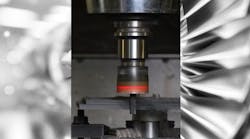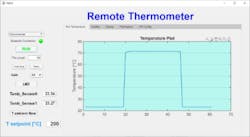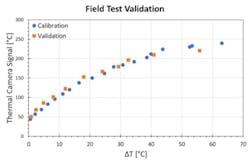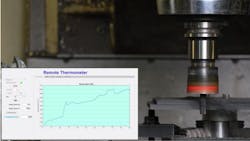Composites represent perhaps the most dynamic area of development in material science, with emerging applications across a spectrum of markets, notably aerospace design and construction. But, being new materials, composites also present problems for the machinists fabricating the parts that designers conjecture.
Their material profiles are different than metals and alloys, and because so many composites are of recent origin there may be no references for gauging how composites react under the heat or stress of machining.
When working with cutting tools, machine operators can only roughly estimate the tool life. Tool vendors can supply tool life data, but often that data is generalized, and inaccurate, because of the variety of applications for cutting tools.
There is a different new development emerging to assist machinists looking for that reliable data.
TemperChip is a noncontact temperature machining data measurement device installed on cutting tools or machine holders. The device is patented as a solution for the machining composite materials while implementing continuous control of the developing temperature measurement. It represents the potential to track several different work parameters between the machine and the work material, and to provide a way to monitor tool life and efficiency.
TemperChip began as an idea, in response to a series of delamination problems that emerged in the process of cutting composite (CFRP) materials specified for a major commercial aircraft program. I found that the main cause of tool failure was the uncontrolled temperature during the milling/cutting process.
Advancing the idea to development took some time, and it was about 12 months later that the first prototype device was ready for testing. In addition to the TemperChip device, a specific software application with graphical user interface was developed to communicate and interpret the measured signals into temperature measurements, and to predict the maximum tool / material temperature.
This effort was followed by some field testing of the temperature differences between the ambient and the highest signal measured during validation.
Estimating the performance life of a tool leads to potential problems. Often, the choice to replace a tool is determined by the machine operator, and relies on his initiative – which means there is potential for human error due to replacing the tool too early or too late.
TemperChip addresses this possibility with a design that includes interactive communication functions to alert operators with red LED lights, smartphone application and/or machine control. Its component parts include various sensors, a miniature battery, an electronic control board, a BLE communication chip, and a recharge chip.
The new measurement device also offers the option to be calibrated according to critical points (10-15% under the limits) that may be expected to cause damage. Calibration is done according to the work specimen and/or workpiece material type.
For example, the glass transition temperature (Tg) of carbon fiber-reinforced polymer (CFRP) causes losses in mechanical properties of the material and delamination occurs at 130°C. Under these conditions, the device will be calibrated to around 110-115°C.
Based on the data collected from the TemperChip device, operators can adjust a machine’s working parameters, stop the operation, and replace the tool as needed. The available measurement parameters include process temperature, load and torque, vibrations and cutter wear.
When the machining process meets the threshold points as indicated, an LED light on the device warns the operator. He can stop the machine manually, or replace a tool.
Next, the machine can optionally receive communication transmitted from the device and start with prevention tactics, such as tool replacement with the magazine, feed-rate reduction, spindle-speed reduction, and a chip-load reduction. In line with Industry 4.0 methodology, the machine controller will be programmed with algorithms that apply the most efficient prevention step, according to the scenario on hand.
By providing the reliable data on the performance of tools when cutting composite materials, TemperChip gives machine operators the evidence and timing for predicting tool life accurately. Even more, it gives operators the means to reduce production costs and promotes high-efficiency tool use, removing the need for a tool-life validation process.
Eli Yudkevich is an aerospace manufacturing specialist. Visit www.eliyudkevich.com










